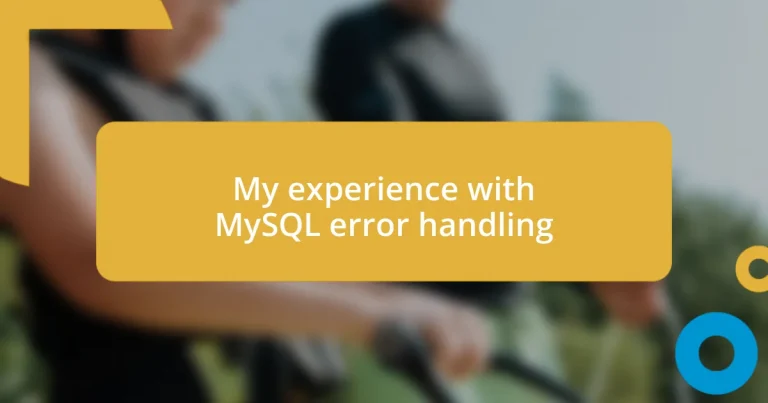Key takeaways:
- Understanding different MySQL error types, such as syntax, runtime, and logical errors, is crucial for effective troubleshooting and database management.
- Implementing proactive strategies like structured exception handling, detailed logging, and regular monitoring significantly enhances error handling and overall database performance.
- Adopting best practices such as breaking down complex queries, proper database design, and input validation can prevent many potential errors and improve user experience.
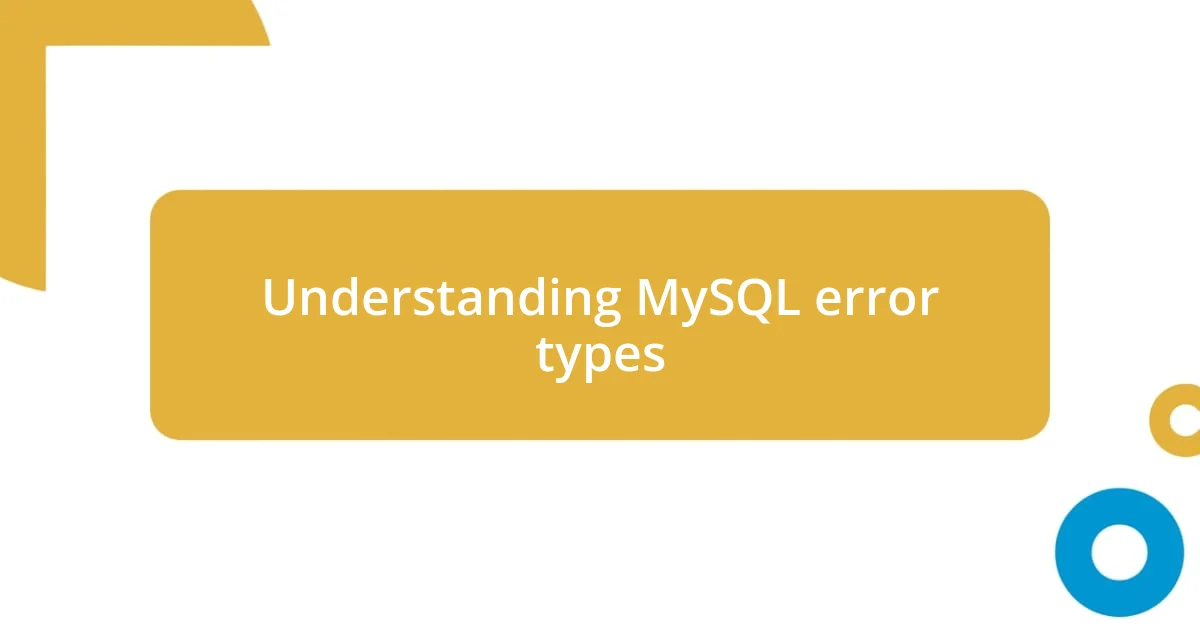
Understanding MySQL error types
When diving into MySQL error types, I often find myself reflecting on moments of frustration during those early days of coding. Error codes can fall into several categories: syntax errors, which occur when the SQL command isn’t structured correctly, and runtime errors, which happen while the command is being executed. Have you ever stared at a complex query, desperately trying to figure out where it went wrong? I know I have; it’s like looking for a needle in a haystack sometimes.
One memorable instance involved a runtime error due to a foreign key constraint. I was so excited about joining tables that I overlooked the importance of ensuring referential integrity. This experience taught me that these constraint violations are not just annoying; they’re crucial for maintaining data accuracy and consistency. Have you ever felt that moment of panic when you realize one misstep could compromise your entire dataset?
On the other hand, MySQL also throws logical errors into the mix, where the query runs without crashing but doesn’t produce the expected results. This type made me question my assumptions and taught me the value of careful analysis—double-checking my logic and understanding my data model deeply. It’s a humbling reminder: even with the right syntax, a stray thought can lead you astray.
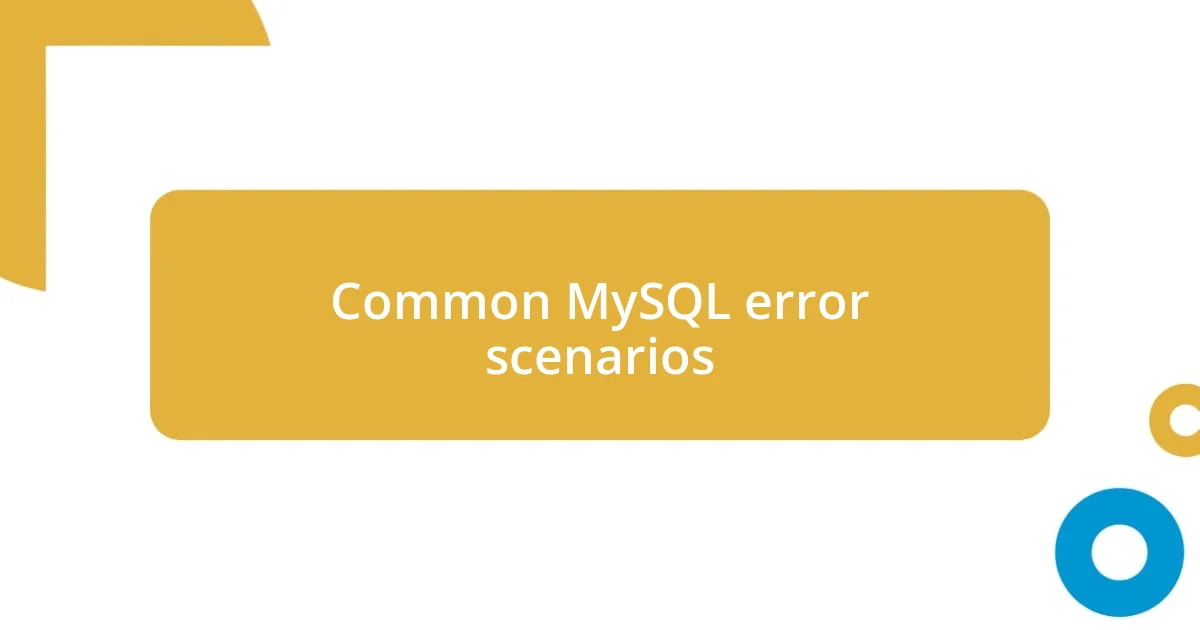
Common MySQL error scenarios
When working with MySQL, I’ve encountered my fair share of common error scenarios that teach you valuable lessons. One time, I faced a “table not found” error because I had misspelled the table name in my query. It was a frustrating moment, but it reminded me of the importance of attention to detail in database management. These simple typos can lead to hours of confusion.
Here are some frequent error scenarios I often bump into:
- Syntax errors: Often caused by missing commas or unmatched parentheses.
- Duplicate entry errors: Occur when trying to insert a record that violates a unique constraint.
- Connection errors: Happens when the database server is unreachable or credentials are incorrect.
- Out-of-memory errors: This one taught me about query optimization; overloading the server with heavy queries is a mistake you don’t want to make.
- Lost connection errors: Typically arise from long-running queries or network issues, a reminder to monitor your connections actively.
Each of these scenarios acted like a wake-up call for me, reinforcing the need for meticulousness and thorough testing in my MySQL endeavors.
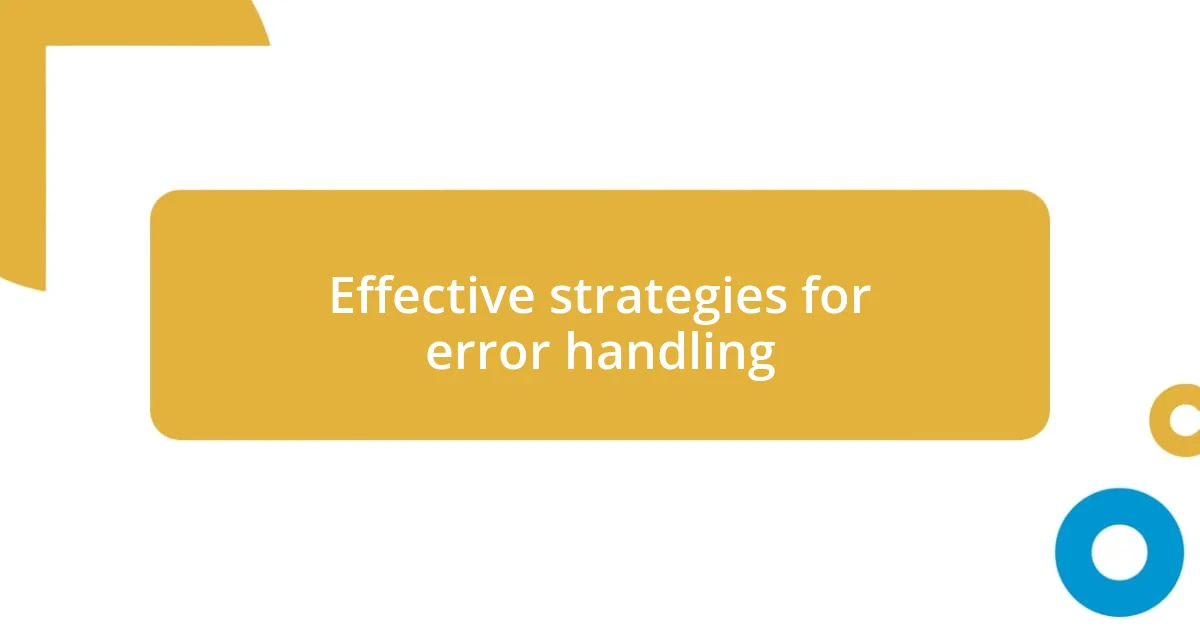
Effective strategies for error handling
When it comes to effective error handling in MySQL, I’ve learned to embrace a proactive mindset. For instance, implementing structured exception handling in my code has been a game changer. By catching errors early, I can promptly address them instead of letting them spiral into larger issues. Have you ever resolved a problem before it snowballed? That’s the beauty of anticipating potential pitfalls.
I’ve also found the value in logging errors meticulously. Whenever a query fails, I take the time to document the error message and the context. This practice not only helps me troubleshoot faster but also builds a valuable repository of knowledge over time. In one instance, I characterized recurring “database deadlock” errors through logging. I was able to identify patterns and optimize my queries, leading to an impressive boost in performance. Don’t underestimate the power of learning from past mistakes!
Lastly, regular database monitoring and performance tuning should never be overlooked. Monitoring tools can alert you to issues like slow queries or connection limits before they escalate into significant problems. I vividly remember a day when a simple query hit a wall, causing a domino effect that impacted my entire application. This moment forced me to reassess my monitoring strategy, ensuring I now sift through metrics regularly. How often do you check your database performance? If you haven’t been keeping an eye on it, I highly recommend starting today.
| Strategy | Description |
|---|---|
| Structured Exception Handling | Catch and manage errors early to mitigate impacts. |
| Detailed Logging | Document error messages and contexts for quicker troubleshooting. |
| Active Monitoring | Keep an eye on database performance to prevent critical issues. |

Using try-catch for exceptions
Using try-catch for exceptions is one of those practices that has truly transformed how I handle errors in MySQL. When I first started coding, I often overlooked the importance of catching exceptions. I vividly remember a particular instance when my application crashed simply because I neglected to handle a potential database connection failure. It was an eye-opener; now I wouldn’t dream of running my queries without wrapping them in a try-catch block.
Implementing try-catch in my MySQL queries not only helped me catch errors on the fly but also allowed me to provide meaningful feedback to users. By catching exceptions, I could display user-friendly messages instead of cryptic database error codes. This change significantly improved user experience. Have you ever wanted to shield your users from technical jargon? I certainly did, and using try-catch was my answer to keeping things smooth and understandable.
While adopting try-catch, I also learned the value of refining my error messages. Instead of generic “error occurred” responses, I started crafting specific messages that could guide my next steps. For instance, after catching an exception related to a unique constraint violation, I might inform the user that a similar record already exists. This small shift made troubleshooting a lot less frustrating and kept my development process flowing. Have you explored the impact of well-defined error handling on your workflow? Trust me, it can make all the difference when managing exceptions.
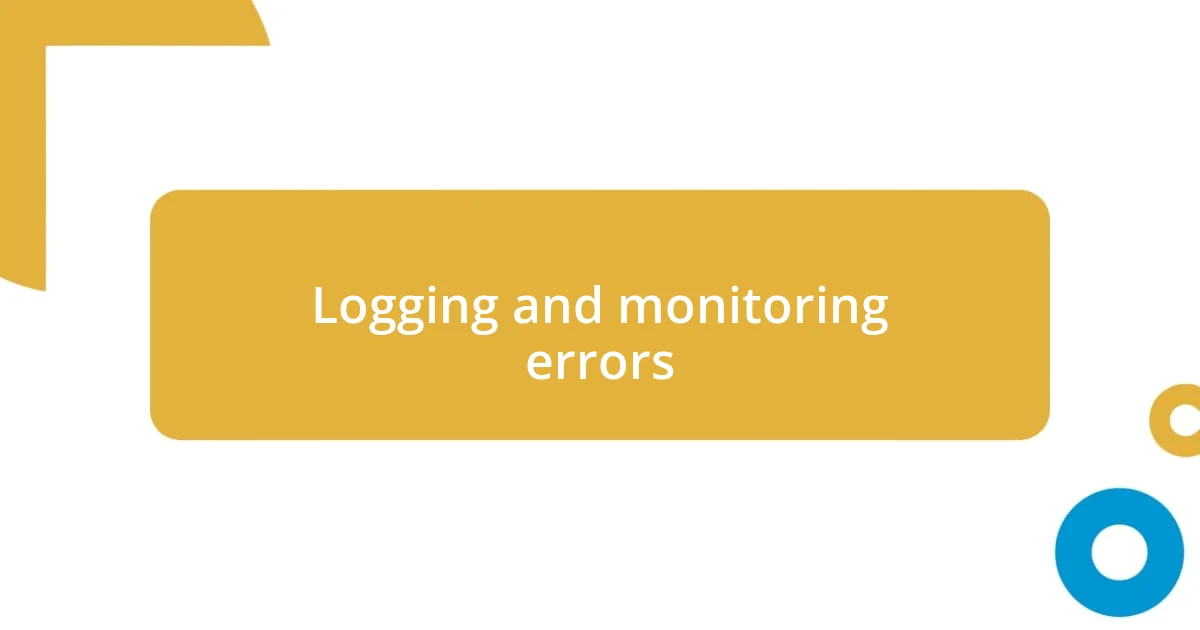
Logging and monitoring errors
One of the most satisfying aspects of error handling in MySQL is the satisfaction that comes from robust logging. I recall a time when a production error led me down a rabbit hole of confusion. It wasn’t until I went back through my logs that I discovered an obscure error message hidden among mundane entries. That experience really taught me the importance of not just logging errors, but also ensuring that I include timestamps and context for each one. This small detail has since proven invaluable, allowing me to quickly correlate events and pinpoint issues, especially when they arise unexpectedly.
Monitoring errors in real-time is another area where I’ve seen significant improvements. For instance, I implemented a basic alert system that notifies me whenever an error threshold is met. I remember the relief I felt when I received a prompt notification about a sudden spike in failed queries. This immediate insight allowed me to address the issue before it affected users, maintaining a seamless experience for everyone. Have you thought about how real-time monitoring could transform your strategy? Trust me, it feels fantastic to stay one step ahead.
Over time, I’ve realized that logging and monitoring aren’t just administrative tasks; they’re opportunities for growth. Analyzing logs has helped me uncover not just problems, but also trends that inform my development practices. I once noticed a pattern of timeout errors occurring during peak usage hours. By addressing this, I wasn’t just fixing a problem—I was actively improving the user experience. It’s incredible how much I’ve learned about my applications by simply paying attention to these logs. Are you ready to dive deeper into logging and monitoring? There’s so much to gain from engaging with data in real-time!
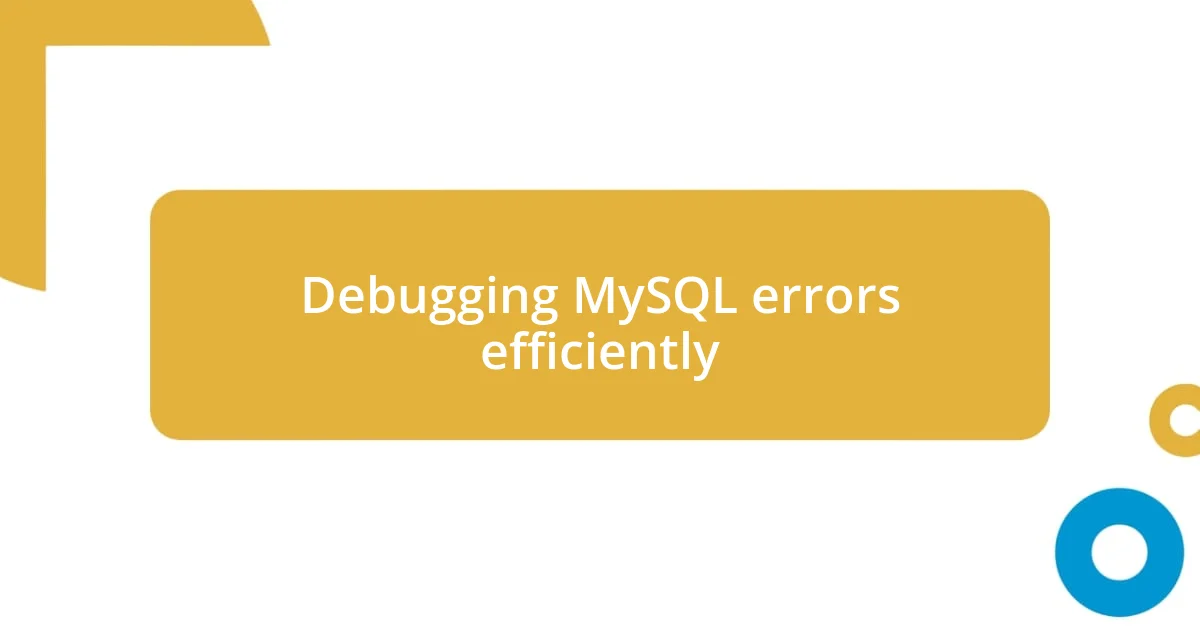
Debugging MySQL errors efficiently
When it comes to debugging MySQL errors efficiently, I’ve found that having a systematic approach can save a lot of headaches. I remember a time when I was chasing my tail over a recurring syntax error in my queries. Instead of diving directly into the query code, I sat down to break down the problem into manageable parts. This method not only clarified my thinking but also allowed me to identify the root cause—an overlooked semicolon. Have you ever considered stepping back, reassessing the situation, and tackling errors in chunks? It can turn a frustrating process into a more controlled one.
Another technique I employ is using specific tools to dissect errors. For example, I often find myself leveraging MySQL’s SHOW WARNINGS command. There was a particular instance where a seemingly harmless query was returning unexpected results. By using this command, I was able to get detailed information about what went wrong. It was enlightening to see how often these small, overlooked details—like data type mismatches—can have unexpected impacts. Do you have tools in your toolkit that help you uncover these hidden insights? It’s definitely worth exploring.
Lastly, I can’t stress enough the importance of community resources when debugging. Early in my journey, I stumbled upon forums and documentation where other developers shared their experiences. I vividly recall asking a question about a tricky join operation that was making my head spin. The insights from seasoned professionals not only guided me to a solution but also inspired me to contribute back to the community later. Engaging with others not only broadens your own knowledge but also makes the debugging process feel collaborative rather than isolating. So, how often do you reach out to your peers for help? Sometimes, a fresh perspective is all it takes to turn a stumbling block into a stepping stone.
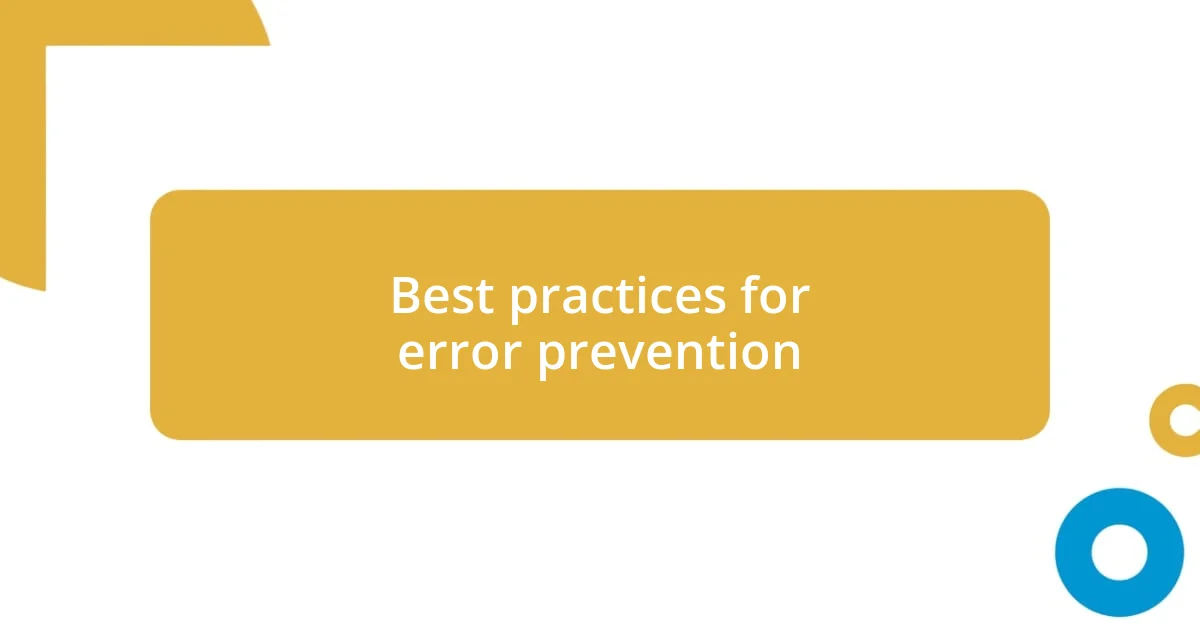
Best practices for error prevention
One key best practice for preventing errors is to adopt a methodical approach to query writing. I vividly remember my early days with MySQL, crafting complex queries that often resulted in errors. Over time, I’ve learned to break these queries down into smaller components, testing each part along the way. This approach not only minimizes the likelihood of mistakes but also makes debugging easier. Have you tried this technique? It can change the game by clarifying your thought process and enhancing your understanding of how each query functions.
Another important aspect is proper database design. I once encountered a project where poor normalization led to frequent data inconsistencies and unnecessary complications. This experience prompted me to invest time in learning about database normalization principles. Now, I take extra care to structure my databases correctly from the start. It’s fascinating how a well-designed schema can act as a solid foundation, preventing many potential issues before they even arise. Have you assessed your database’s design lately? A little effort here could save you a multitude of headaches later on.
Additionally, setting up comprehensive validation checks is crucial for error prevention. I recall a specific project where I failed to validate user inputs. This oversight led to several frustrating crashes and unpredictable behavior in my application. Now, I prioritize input validation, ensuring that each data entry adheres to defined rules before processing. This proactive step not only enhances reliability but also improves user experience. So, are you giving enough attention to the inputs your applications receive? Implementing thorough validation checks can make all the difference in creating a robust system.












